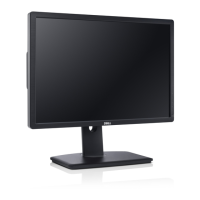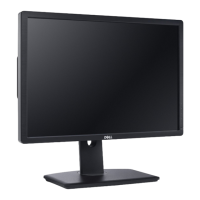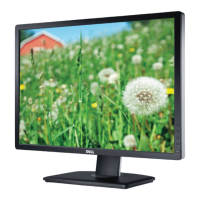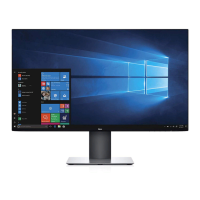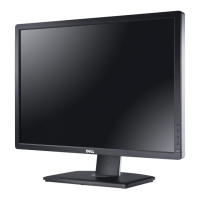Do you have a question about the Dell U2414H and is the answer not in the manual?
List of items included with the monitor.
Detailed specifications and capabilities of the monitor.
Locating and understanding monitor buttons and ports.
Identifies front panel controls and buttons.
Identifies rear panel ports and mounting points.
Identifies side and bottom panel connectors and features.
Technical data including panel, resolution, and electrical specifications.
Dimensions, weight, and connector types of the monitor.
Operating temperature, humidity, altitude, and thermal dissipation.
How the monitor conserves power and its different operating states.
Detailed pinouts for the DisplayPort connector.
Detailed pinouts for the Mini DisplayPort connector.
Detailed pinouts for the HDMI connector.
Detailed pinouts for the MHL connector.
How the monitor automatically configures with the computer.
Information about the monitor's USB ports and speeds.
Information on accepted pixel defects and quality standards.
Instructions for cleaning and maintaining the monitor.
Step-by-step instructions for attaching the monitor stand.
General instructions for connecting the monitor to a computer.
How to connect and use MHL devices with the monitor.
Methods for tidying and managing monitor cables.
Instructions for installing and removing the monitor's cable cover.
Steps to detach the monitor stand from the display.
Guide for mounting the monitor on a wall using a VESA kit.
How to turn on the monitor and use its physical buttons.
How to access and navigate the monitor's settings menu.
Adjusting the monitor's screen brightness and contrast levels.
Selecting the active video input signal for the monitor.
Adjusting color parameters like input format and gamma.
Adjusting the monitor's gamma settings for PC or MAC.
Selecting pre-defined color and display settings for different applications.
Configuring aspect ratio, sharpness, and DisplayPort 1.2 settings.
Managing power modes, USB settings, and power LED behavior.
Customizing OSD language, transparency, timer, lock, and reset options.
Configuring button sounds, DDC/CI, and LCD conditioning.
Assigning features to shortcut keys for quick access.
Explanations for common on-screen warning messages.
Steps to set the monitor to its optimal 1920x1080 resolution.
How to adjust the monitor's physical position for comfortable viewing.
Details on extending the monitor stand vertically.
Instructions for rotating the monitor screen.
Recommendations for setting up multiple monitors side-by-side or top-bottom.
How to configure screen rotation in the operating system.
Procedure to test monitor functionality without a computer.
Running internal diagnostics to identify screen or hardware issues.
A table of common monitor issues and their solutions.
Troubleshooting specific issues related to screen size and OSD.
Troubleshooting issues with USB and MHL peripheral connectivity.
Regulatory compliance information, FCC notices, and support contact details.
Detailed steps to set the display resolution in Windows.
List of items included with the monitor.
Detailed specifications and capabilities of the monitor.
Locating and understanding monitor buttons and ports.
Identifies front panel controls and buttons.
Identifies rear panel ports and mounting points.
Identifies side and bottom panel connectors and features.
Technical data including panel, resolution, and electrical specifications.
Dimensions, weight, and connector types of the monitor.
Operating temperature, humidity, altitude, and thermal dissipation.
How the monitor conserves power and its different operating states.
Detailed pinouts for the DisplayPort connector.
Detailed pinouts for the Mini DisplayPort connector.
Detailed pinouts for the HDMI connector.
Detailed pinouts for the MHL connector.
How the monitor automatically configures with the computer.
Information about the monitor's USB ports and speeds.
Information on accepted pixel defects and quality standards.
Instructions for cleaning and maintaining the monitor.
Step-by-step instructions for attaching the monitor stand.
General instructions for connecting the monitor to a computer.
How to connect and use MHL devices with the monitor.
Methods for tidying and managing monitor cables.
Instructions for installing and removing the monitor's cable cover.
Steps to detach the monitor stand from the display.
Guide for mounting the monitor on a wall using a VESA kit.
How to turn on the monitor and use its physical buttons.
How to access and navigate the monitor's settings menu.
Adjusting the monitor's screen brightness and contrast levels.
Selecting the active video input signal for the monitor.
Adjusting color parameters like input format and gamma.
Adjusting the monitor's gamma settings for PC or MAC.
Selecting pre-defined color and display settings for different applications.
Configuring aspect ratio, sharpness, and DisplayPort 1.2 settings.
Managing power modes, USB settings, and power LED behavior.
Customizing OSD language, transparency, timer, lock, and reset options.
Configuring button sounds, DDC/CI, and LCD conditioning.
Assigning features to shortcut keys for quick access.
Explanations for common on-screen warning messages.
Steps to set the monitor to its optimal 1920x1080 resolution.
How to adjust the monitor's physical position for comfortable viewing.
Details on extending the monitor stand vertically.
Instructions for rotating the monitor screen.
Recommendations for setting up multiple monitors side-by-side or top-bottom.
How to configure screen rotation in the operating system.
Procedure to test monitor functionality without a computer.
Running internal diagnostics to identify screen or hardware issues.
A table of common monitor issues and their solutions.
Troubleshooting specific issues related to screen size and OSD.
Troubleshooting issues with USB and MHL peripheral connectivity.
Regulatory compliance information, FCC notices, and support contact details.
Detailed steps to set the display resolution in Windows.
| Screen Size | 23.8 inches |
|---|---|
| Panel Type | IPS |
| Aspect Ratio | 16:9 |
| Refresh Rate | 60 Hz |
| Brightness | 250 cd/m² |
| Color Support | 16.7 million colors |
| Resolution | 1920 x 1080 |
| Contrast Ratio | 1000:1 |
| Viewing Angles | 178°/178° |
| Connectivity | DisplayPort, Mini DisplayPort |
| VESA Mount | 100 x 100 mm |
| Weight | 3.61 kg (without stand); 5.66 kg (with stand) |


